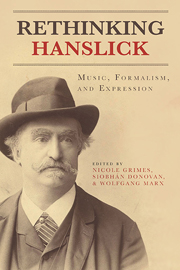Book contents
- Frontmatter
- Contents
- Foreword by Mark Evan Bonds
- Acknowledgments
- Abbreviations
- Chronology
- Introduction
- Part One Rules of Engagement
- 1 Negotiating the “Absolute”: Hanslick's Path through Musical History
- 2 Hanslick's Composers
- 3 Hanslick, Legal Processes, and Scientific Methodologies: How Not to Construct an Ontology of Music
- 4 Otakar Hostinský, the Beautiful, and the Gesamtkunstwerk
- Part Two Liberalism and Societal Order
- Part Three Memoirs and Meaning in Social Contexts
- Part Four Critical Battlefields
- Selected Bibliography
- List of Contributors
- Index
4 - Otakar Hostinský, the Beautiful, and the Gesamtkunstwerk
from Part One - Rules of Engagement
Published online by Cambridge University Press: 05 July 2013
- Frontmatter
- Contents
- Foreword by Mark Evan Bonds
- Acknowledgments
- Abbreviations
- Chronology
- Introduction
- Part One Rules of Engagement
- 1 Negotiating the “Absolute”: Hanslick's Path through Musical History
- 2 Hanslick's Composers
- 3 Hanslick, Legal Processes, and Scientific Methodologies: How Not to Construct an Ontology of Music
- 4 Otakar Hostinský, the Beautiful, and the Gesamtkunstwerk
- Part Two Liberalism and Societal Order
- Part Three Memoirs and Meaning in Social Contexts
- Part Four Critical Battlefields
- Selected Bibliography
- List of Contributors
- Index
Summary
Introduction
Most of the reactions to Eduard Hanslick's monograph Vom Musikalisch-Schönen during the author's lifetime have either a decidedly polemical or a flattering ring to them. The result is that Hanslick's theories on musical aesthetics are often abbreviated to handy catch-phrases, a practice that attests to the ideological prejudice of many of his contemporaries, and that has subsequently prevented an objective and substantive dialogue with his aesthetic theory. Despite avoiding such a polemical tone, Das Musikalisch-Schöne und das Gesammtkunstwerk vom Standpunkte der formalen Ästhetik, published by Otakar Hostinský (1847–1910) in 1877, was poorly received and is largely forgotten today. The Czech aesthetician's critical musings on Hanslick's theories were intended to give a philosophical justification for a redefinition of the relationship between the two most important trends in music aesthetics of the late nineteenth century. As the title of his book indicates, Hostinský is at pains to draw together the category of the musically beautiful coined by Hanslick and the idea of the Gesamtkunstwerk as advocated by Wagner in his theoretical writings.
- Type
- Chapter
- Information
- Rethinking HanslickMusic, Formalism, and Expression, pp. 70 - 88Publisher: Boydell & BrewerPrint publication year: 2013

